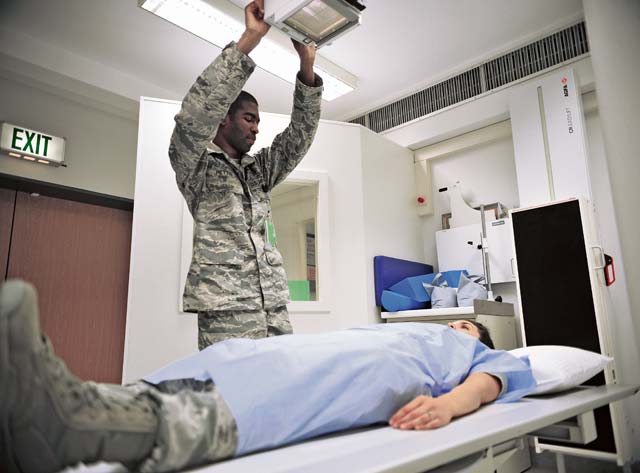
Whether a broken bone or an annual chest X-ray for a flyer, the 86th Medical Support Squadron Radiology Clinic is crucial in keeping Airmen healthy and deployable.
An X-ray is defined as an electromagnetic wave of high energy and very short wavelength that is able to pass through many materials opaque to light. Though radiology technologists deal with them on a daily basis, there is much more to their job.
Having 259 days of training, radiology technologists go through one of the longest technical schools in the military. The training is a lot more extensive than just how to push a button.
“We have to know what’s going on the second we push the button to take the X-ray — how the protons and neutrons work (and) the different angles and such,” said Senior Airman Travis Pettis, 86th MDSS radiology technologist. “It’s a lot more than what people expect, and that’s why we’re called technologists. We know the science of how X-rays work.”
The Radiology Clinic works closely with Landstuhl Regional Medical Center. Radiographs taken at Ramstein are sent over to the radiologist at LRMC to be assessed.
Though LRMC has the equipment to offer more services, the 86th MDSS Radiology Clinic is an important first line for X-rays. Many patients are referred to the clinic for an initial visit.
“At Ramstein, we do basic X-rays,” said Staff Sgt. Timothy Jenkins, 86th MDSS NCO in charge of diagnostic imaging. “We do chest X-rays; flyers need those annually. We also do anything from the routine things
active-duty personnel need, such as a chest X-ray for a positive tuberculosis skin test or chest X-rays before retirement, all the way to family health care.
“We make sure our active-duty members are healthy enough to carry out the mission,” he continued. “We’re important to flyers, for example, because they rely on us a lot. If anything’s even a little off, they may be restricted from their primary flying duties. We’re helping the doctors know how to keep people in top shape.”
In a recent biennial inspection, conducted by the Accreditation Association for Ambulatory Health Care, the 86th MDSS Radiology Clinic earned a perfect score without any markdowns.
“My favorite part of my job is interacting with the patients,” said Senior Airman Silvia Ruiz, 86th MDSS radiology technologist. “We may not see them for very long, but we can still have an impact on their care in the clinic. I get to be the last person they see, and it feels good when they leave with a smile.”
For Airmen interested in retraining into radiology, the Radiology Clinic offers a program allowing Airmen and even high school students to experience a typical day in the clinic.
“We have a shadow program that’s about to start back up,” Ruiz said. “It was interesting, because they have their idea of what we do, then we show them what we actually do. They’re surprised we do more than just X-rays. We show them how we fix images to send to the radiologist, how we send it and all the different pathways it goes through; many people don’t know that part of our job. Some think we just sit in a booth and push a button, but there’s so much more than that.”
A patient needing an X-ray must be referred to the clinic by their doctor. X-rays require radiation to give a good picture; therefore, they cannot be administered without a doctor’s consent.
The work of the radiology staff enables military members to remain resilient and deployable and their families to remain healthy.







